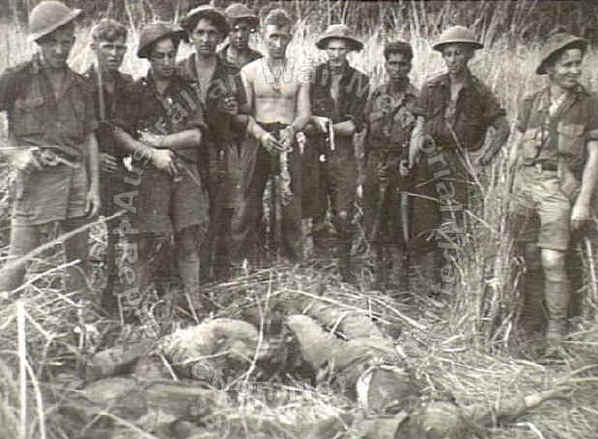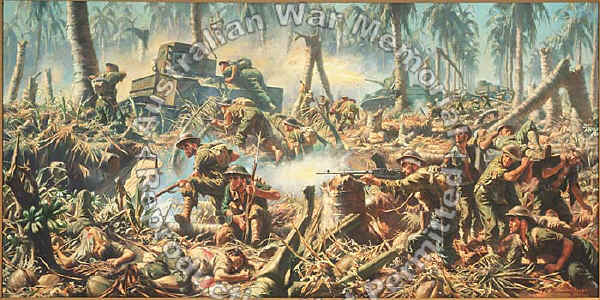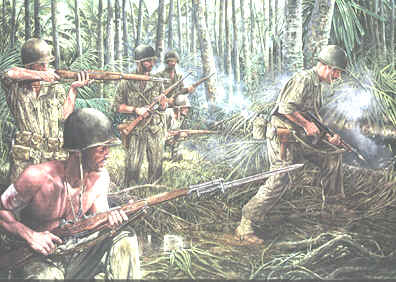 |
|
|||
|
|
||||
| The Buna, Gona & Sanananda Campaigns |
| Although the fanaticism of the Japanese commanded respect, their barbarism was appalling. Not one of the Allied soldiers taken prisoner by them in the whole six months of the campaign had been allowed to live. Moreover, a number of those captured were found to have been eaten, tortured, or used for bayonet practice. see below for full story |
|
|
| 1942-12-17. Papua. Fall Of Gona. Australians Who Cleaned Out A Pocket Of Japanese In The Final Assault On Gona. The Five Dead Japanese In The Foreground Were Killed By A Grenade Thrown By An Australian. The Japanese Suddenly Stood Up Five Or Six Yards Away And Threw His Rifle With Fixed Bayonet Spear Fashion. The Australian Dodged And Tossed In Several Hand Grenades. He Killed Five Japanese. |
|
BUNA, GONA and SANANANDA NOVEMBER 1942-JANUARY 1943
As the northern end of the Kokoda Trail came down to the coast the terrain changed to a mix of dense jungle, foetid swamps and eight-foot high kunai grass in which the temperature was about 50 degrees Celsius. These conditions were host to new health threats. The 2/1st alone lost 17 men from scrub typhus, and all were plagued by malaria, diarrhoea and dysentery for which little medicine was available. The opposing forces also had changed. The Japanese had fought stubbornly in the battles on the Trail, but now they had their backs to the sea and had been instructed to fight to the death. And they were doing so from their base where, until the final stages, reinforcements and resupplies were continually arriving. There they had strongly fortified defences containing concealed bunkers with deep overhead cover. These bunkers were sited in mutually supporting positions which produced a devastating crossfire. Approaching them were Australian units which were much depleted and suffering the effects of two-and-a-half months of continuous fighting on the Trail. Their maps were inaccurate and they had virtually no knowledge of the enemy's defences which were in three main areas-Gona, Sanananda, and Buna to Cape Endaiadere. Air photographs were not received until 18 December-and then only in inadequate numbers. The first contact at Gona was made by a patrol from the 2/33rd Battalion on 19 November 1942. The 2/31st, which was leading the 25th Brigade, swept into the attack-but suffered 32 casualties. A brigade attack was launched on 22 November, but it gained only about 50 metres and cost the 2/31st 14 killed, 45 wounded and 8 missing. Repeated attacks incurred relatively high casualties for similar small gains. The Japanese were so well protected that a six hour air bombing achieved little. The 25th Brigade was reinforced by the 3rd Battalion, and then the 21st Brigade arrived, followed by the 39th Battalion. Gradually, the Australians closed in. On 9 December, the commanding officer of the 39th Battalion, Lieutenant-Colonel Ralph Honner, sent the now-famous laconic message: 'Gona's gone' . At that stage, the 2/27th Battalion had only 92 officers and men left, and the position was far from secure-for there was a significant enemy force in the Amboga River area. This force was made up of reinforcements for the main battle, who had been forced by air attacks to land further north, and of survivors of earlier fighting in the mountains who had escaped down the Kumusi River. On 10 December, the 39th Battalion moved west to deal with the threat. Post after post was taken out, and the battalion linked up with the 2/14th Battalion which was on the coast. Finally, in a dawn attack on 18 December, they over-ran the last defences. On the Sanananda front the 2/1st made solid contact on 20 November. Its commanding officer, Lieutenant-Colonel Paul Cullen, sent two of his (by then small strength) companies in a flanking movement aimed at cutting the tracks behind the opposition. After a nine-hour approach march, they came across a strongly held important section of the main track. Without hesitation, they attacked and captured it but, of the 90 man force, 31 were killed and 36 wounded. The Japanese were forced to retire, and the 2/1st closed up. The 30th Brigade commenced to relieve the 16th Brigade on 6 December, and its 49th and 55th/53rd Battalions went into the attack almost immediately. Considerable penetration was achieved in places but, by day's end on 7 December, 359 casualties had been sustained, and the brigade was unable to consolidate its gains. Reinforced by the 36th Battalion and the 7th Division Cavalry Regiment on foot, the brigade tried again on 19 December but after three days' fighting-remained unsuccessful. The 39th Battalion rejoined the 30th Brigade but there was still insufficient strength for a major attack. Although a whole American division had been injected into the campaign, it had not been properly prepared, both mentally and physically, and it required training and changes of command. Finally, the experienced 18th Brigade-with tanks and artillery brought in from Milne Bay-tipped the scales. They were first employed on 18 December attacking north to Cape Endaiadere and west to Sinemi Creek. It was a hard-fought battle, and of 87 men who crossed the eastern end of the start line, 47 were shot down in less than 10 minutes.
The year of 1943 opened with fighting as fierce as any in the campaign. On New Year's Day, in an infantry and tank advance, the 2/12th Battalion suffered 45 killed and 127 wounded, but the advance reached Giropa Point. On the following day, the Buna Government Station fell.
Back on the Sanananda front, another major attack was mounted on 12 January. The 2/12th was the principal unit used and it suffered 99 casualties without succeeding. However, the attack-coming after the weeks of ordeal that the Japanese had endured put an end to their resolve, and they commenced to withdraw. The 18th Brigade quickly followed up. Cape Killerton to Sanananda Point remained to be cleared, and a large number of casualties was the price paid in doing so. Finally, by 22 January, the Japanese defences had been overcome-although mopping-up was to take more time. Those entering the Japanese bunkers were confronted by the nauseating presence of unburied dead, suppurating wounded and body wastes. Although the fanaticism of the Japanese commanded respect, their barbarism was appalling. Not one of the soldiers taken prisoner by them in the whole six months of the campaign had been allowed to live.
Australian casualties were heart-breaking. The 39th Battalion had been the first battalion into action on the Trail and, when it was finally flown to Port Moresby on 25 January 1943, it took up only 32 places. Sadly, many Australian casualties were due to the American general commanding the South-West Pacific Area-Douglas MacArthur-who had fled the Philippines and arrived in Australia on 17 March 1942. MacArthur had outstanding military ability, but he was not a soldiers' soldier. He never ventured beyond Port Moresby, and never took the trouble to familiarise himself with either the terrain or the enemy's defences. Yet, for his own publicity purposes, he applied great pressure for quick results-which were quite impossible in the circumstances. He caused attacks to be mounted without adequate preparation, without adequate support, and astride approaches that held no hope for success. |
|
RED ARROW AT WAR: THE 32d INFANTRY DIVISION AT BUNA . |
||
|
Papua, New Guinea, December 1942 |
||
Elements moved to Port Moresby, New Guinea, in September 1942, in order to halt the Japanese invasion which threatened Australia. The Red Arrow's 126th Infantry Regiment went by ship; the 128th Infantry was airlifted in the first mass troop movement by air in World War II. Joining the Australians, the 32d entered combat on 16 November 1942. The Allied forces were to take heavily-fortified Japanese positions at Buna, on New Guinea's southeast coast. It proved to be one of the most difficult campaigns of the war. Fighting in the hot, steamy jungles, the 32d was desperately short of basic equipment, weapons, medicine and even food. In the terrible heat and drenching rain the men of the 32d, many of them burning with fever, had to reduce Japanese positions one at a time, usually by rushing them with grenades. Most of the Japanese fought to the death, but finally, on 2 January 1943, Buna fell. It was the Japanese Army's first defeat in modern history, but for the 32d Division the cost was high: 1,954 were either killed or wounded, with 2,952 hospitalized due to disease. After Buna, the 12d participated in the long campaign to drive the Japanese from the rest of New Guinea, and went on to see heavy fighting in the Philippines. Today, the 32d Infantry Brigade, Wisconsin Army National Guard, continues to maintain the Red Arrow heritage. |



